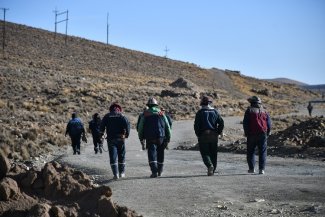Katoku Beach is one of the last remaining beaches in Japan without concrete structures. Since 2014, the local community and Japanese environmentalists have been fighting to keep it that way.
Had it taken place as planned, the 2020 Tokyo Olympics (now postponed to 2021) would have shone a light on Japan’s beaches, which are little-known internationally. Surfing was set to debut as one of five additional sports in the summer Olympics, and Tsurigasaki Beach, where the surfing competition is supposed to be held, has undergone significant redevelopment to accommodate visitors and spectators. With the current global pandemic, there is still much uncertainty surrounding the games, but a three-hour flight away from Tokyo lies another coastal community facing an uncertain future.
“When you explore Sumatra [in Indonesia] via Google Earth, you will find similar-looking, isolated beach-villages with a river-mouth, but these places don’t exist in Japan anymore,” says Jean-Marc Takaki, a resident of Amami Ōshima. This island of 73,000 people is part of the Kagoshima Prefecture, roughly 1,300 kilometres south-west of Tokyo. In the south-east of the island lies the hamlet of Katoku, home to one of the last remaining beaches in Japan without concrete structures, and the only place in the country where the critically endangered leatherback sea turtle has been spotted laying eggs.
Thanks to its isolated location and the resilience of the people who call it home, Katoku has retained its wild, pristine beauty. With its white sand beach surrounded by a lush, tropical valley, and natural river-mouth that flows directly into the sea, you can see how Katoku earned its ‘Jurassic Beach’ nickname, offering a rare example of a place where, until recently, time really stood still. But modernity began to catch up in 2013 following a series of public works greenlit by the local government, which disrupted the natural course of the River Katoku, resulting in its naturally occurring sandbars, which helped shelter the coastline from wave action and potential erosion, all but disappearing.
Two subsequent typhoons hit the coast in October 2014, causing major erosion and damaging the Pandanus forest that lined the beach. This prompted the municipality to propose a US$5.5 million construction project for a six-metre tall and 530-metre long concrete seawall that would extend along the beach and around the river bend on the premise that it would protect the coastline from eroding.
Since then, however, several Category 5 typhoons have sent massive waves to the shores of Katoku – and yet the beach stands uncorroded. In fact, measurements taken by the Nature Conservation Society of Japan (NACS-J) and local volunteers from 2014 and 2017 show that the width of the shoreline expanded naturally (as sandy beaches do) from 40 metres to 100 metres: the widest it had been in 10 years.
Having witnessed some of his favourite childhood beaches undergo artificial alterations, Takaki, who grew up in France and moved to Amami Ōshima from Paris, was already aware of the increasing amount of concrete appearing along the country’s coastline, directly impacting not only the landscape and wildlife but also a place’s identity. Describing Katoku as a “Shangri-La in Japan”, he and his partner set out to establish the Association for the Conservation of Amami’s Forests, Rivers and Coastal Ecosystems (ACARFCE) in 2015, hoping to avert the seawall project.
Although the river diversion works were discontinued at the end of 2017 with the help of NACS-J, preparations for the construction of the wall (rescaled to 180 metres long and 6.5 metres tall, which is still almost three-storeys-high) began in September 2019. “Despite all our efforts – a growing petition campaign [currently over 30,000 signatories], multiple reports and requests by NACS-J and other local associations, plus requests and recommendations by independent scientists and researchers – the local government and Kagoshima Prefecture has shown no intention to reassess the legitimacy of this project,” says Takaki.
A controversial history of “concrete addiction”
Coastal armouring is part of a trend that emerged in Japan in the 1950s, when the government began to invest large sums of money in civil engineering projects such as roads, dams, tunnels, harbours and seawalls. It was part of a post-war development model that sought to modernise the country and boost its GDP. Consequently, this policy has moulded a mindset in which “natural surfaces that have been flattened and paved over are considered modern,” as Japanologist and author Alex Kerr explained to the Kyoto Journal. “[It’s] a mindset that stuck back in the fifties when Japan was still poor and was desperately trying to recover from the war.”
Amongst the development legislation emerging from this period was the Special Measure Law for the Reconstruction of the Amami Islands, currently known as the Amashin Law. Introduced in 1954, it sought to narrow the income gap between Amami Ōshima and mainland Japan, making the island economically independent through the promotion of large-scale construction projects.
Despite calls for revision every five years, the Amashin Law continues to allocate nearly 80 per cent of Amami’s annual 30 billion yen (roughly US$277 million) budget to civil engineering works, the same percentage apportioned 66 years ago. This places both the people and the environment in a political quandary where, by lobbying for further public works, politicians guarantee jobs for the local people – as well as votes.
“Most of the budget is used to destroy the natural environment with pork-barrel public works, with contracts given to big construction companies from Kagoshima [City]. Locals only get the crumbs, working part-time jobs six to seven days a week on minimum wage and no job security,” explains Takaki. In 2017, the Kagoshima Prefecture added to the controversy surrounding the seawall project by setting up a committee of its own, excluding members of the general public and the ACAFRCE, and disregarding the association’s ongoing petition for a public debate.
Another brick in the wall
Japan has had an Environmental Impact Assessment Law (EIA) in place since 1999, which allows authorities to regulate large-scale construction projects and halt those deemed excessively detrimental to the environment. However, seawall projects are exempt from the EIA and can proceed without undergoing assessment.
“Seawalls or rip rap revetments are built to protect the area inland of the beach or shoreline, but not the beach, and in fact have clear negative impacts on the beach. With rising sea levels, passive erosion will gradually take place, leading to loss of the beach as water levels rise and the shoreline and beach cannot retreat inland,” says Gary Griggs, a professor of earth and planetary sciences at the University of California, Santa Cruz, who has published a study about the impacts of coastal armouring.
Furthermore, findings published in the Journal of Coastal Research “indicate that seawalls impact loggerhead sea turtle nesting by reducing nesting success and increasing the likelihood of nests being washed away during storm events.”
Although it remains unclear exactly how turtles detect appropriate nesting habitats, in the case of Katoku, the likelihood of an artificial structure changing the shore profile threatens the population of sea turtles as well as other species whose life cycles are linked to the shore or the river, such as the Ishikawa frog and the Amami black rabbit, which are both on the International Union for Conservation of Nature’s (IUCN) Red List of Threatened Species.
Also reliant on this ecosystem is the identity of Amani’s islanders, whose cultural origins differ from the people of mainland Japan and for centuries have considered the ocean-beach-village unity as sacred. According to a study on the development of small islands in Japan, “people have started pointing out that in this intense pursuit to actualize a higher average income and to reach the level of the mainland islands, the very identity of the Amami islands will be lost”. For future generations, the aftermath seeps into a nature-culture bond that has come to shape their lifestyle through practices such as aizome (indigo dyeing), nature conservation, surfing, ecotourism and organic farming – all of which could help shape a sustainable future in Katoku.
“My main question is what is the need to build such a large expensive structure,” asks Griggs, after examining the seawall blueprint for Katoku. “At this location, vegetation to stabilise the shoreline would seem to be a much more sound, inexpensive and environmentally acceptable approach.”
Katoku as a case study
Although Japan currently lacks legislation to regulate coastal armouring projects, the Ecosystem-based Disaster Risk Reduction (Eco-DRR) plan has outlined legitimate shoreline protection practices since April 2018. In Katoku, alternative plans could revolve around tapping into the network of Pandanus tree roots, which have traditionally been used by the people of Amami for erosion control.
“We started planting Pandanus shoots in the sand in October 2015,” says Takaki. “They have grown tremendously.” Despite the local government neglecting a formal request by the Japan Conservation Society to consider Eco-DRR methods instead of a concrete seawall, Takaki and the local community have soldiered on with the idea and, as of this year, more volunteers have become involved.
Now with the support of five environmental lawyers from the Japan Environmental Lawyers Federation and a lawsuit against the Kagoshima Prefecture on the grounds of misappropriated public funds underway, the aim is to introduce enough scientific evidence to obviate the construction plans. Since the local government hasn’t conducted any impact studies, the ACAFRCE funded its own beach survey with the Coastal Engineering Lab, a Tokyo-based consultancy firm for coastal construction projects. According to Takaki, in the preliminary report sent to the court, the laboratory has stipulated that the erosion events of 2014 did not pose a threat to the community, thus rendering the seawall unnecessary.
“The project hasn’t been halted by the court but it is temporarily suspended by the prefecture, which most likely fears that the pending World Natural Registration could be denied by the IUCN,” notes Takaki, referring to Japan’s request to include Amami Ōshima in the IUCN World Heritage Program. “However, we are well aware that they could start as soon as it is either approved or denied.”
That Katoku stands on the verge of becoming another brick in the wall sheds a light on the improvidence of coastal development projects and the urgency for better assessment. A coastal survey conducted in 1993 showed that over 43 per cent of Japan’s coastline had already been artificially modified. Yet, the Ministry of Infrastructure, Land and Tourism still doesn’t keep track of how many concrete-free beaches are left in Japan.
Perhaps this is also an opportunity to set an example, placing Katoku as a case study for environmental learning and community-led conservation, and as a sign of hope for future generations in Japan. “Katoku is probably the only place with a beach facing the Pacific Ocean and without a seawall in all of Japan,” remarks Takaki. “Its increasingly symbolic value could very well mark a turning point in Japan’s careless destruction of its once magnificent coastline.”










